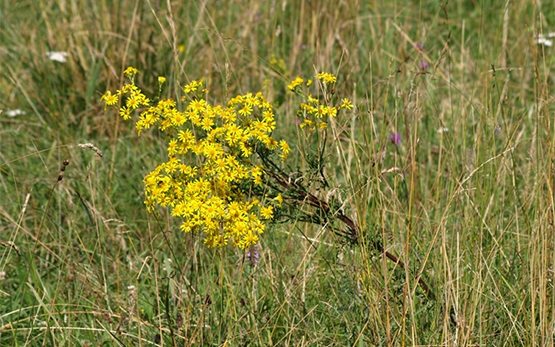
The investigations conducted by Agroscope and AGFF focus on the two poisonous species common ragwort (Senecio jacobaea) and marsh ragwort (Senecio aquaticus). Scantily fertilised, low-input permanent pastures with gappy stands are risk areas for common ragwort. Common ragwort can be successfully contained by targeted mowing: With at least two cuts per year, seed formation is effectively prevented. Such a cutting regime should be maintained over several years in order to control common ragwort over the longer term.
With marsh ragwort the challenge is greater, since this species cannot be suppressed by frequent mowing. On many sites, moreover, investigations revealed a large soil seed bank (over 1000 germinable seeds per square metre) and a high, rapid seed-germination capacity. In addition, we discovered that the success from treatment methods which were highly promising in the short term, such as reseeding after ploughing, low-input management, or herbicide use, was undone by the germination of marsh ragwort seeds after just two to three years.
In a plot trial comprising a series of experiments aimed at reducing the marsh ragwort seed bank, small plots on five sites at the northern edge of the Alps were ploughed or tilled, then resown. Compared to the control, ploughing and tilling reduced seed numbers in the topsoil (0-10 cm) by 80% and 65%, respectively. If ploughing is used to remediate marsh ragwort areas, it is important for the soil to be turned completely and for seedbed preparation for reseeding to be as shallow as possible.
The results show how important prevention is for the control of both species. The plants must on no account be allowed to produce seed, as this would enable the potential formation of a seed bank in the soil. Further spreading of ragwort species can be prevented by avoiding damage to the sward. This is achieved by promoting a dense sward and through the systematic application of control measures upon the appearance of the first individual specimens in the stand.
Publications
Contacts
Further Information
Fact Sheet U7 "Poisonous Ragwort Species in Meadows and Pastures" (Giftige Kreuzkräuter in Wiesen und Weiden; in German), AGFF





